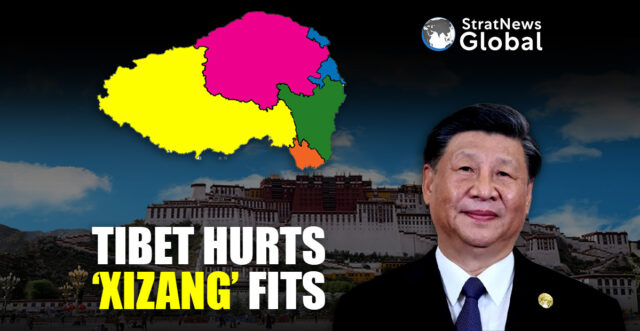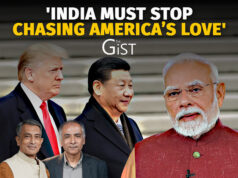White Papers on Tibet published by the State Council Information Office of the People’s Republic of China are a dime a dozen. However, the recent iteration displays a slight alteration from the time-bound, formulaic verbosity typical of the genre, evident in its title, “Human Rights in Xizang in the New Era”.
The almost obsessive repetition of “Xizang” 231 times throughout the document reflects, on one hand, the recent push by the Chinese Communist Party (CCP) to replace “Tibet” with “Xizang” in the lexicon of global and nationalist discourse, while on the other hand, it exposes its increasing insecurity regarding its occupation of Tibet.
The White Paper was released on March 27, 2025, the day Beijing commemorated the 66th anniversary of the “democratic reform” that “abolished feudal serfdom”. China describes the occasion as a “significant milestone” representing a “monumental leap in the history of human civilization and global human rights”.
Superficial Data
As expected, the lack of substantial arguments to justify the appealing contents further validates the Chinese government’s negligence in understanding the intricate elements of human rights or its failure to do so. The actual information in the document is superficial. The only data, limited as it is, that appears in the White Paper is focused on transport infrastructure, which, unsurprisingly, neither guarantees the protection of human rights nor ensures economic benefits to the Tibetans. Beijing’s rhetoric concerning “safeguarding national unity” and “combating separatist forces” as its primary focus in the region (Tibet) does not effectively inform or persuade the international community about the true state of human rights in Tibet.
Reading between the lines, the paper reflects broader policies and core principles that drive the Chinese government’s management of religious affairs, as well as linguistic, educational and cultural rights. The White Paper fundamentally reiterates its fierce propaganda narrative claiming “undisputed” control and legitimacy over recognising the reincarnation of Tibetan Buddhist figures, including that of His Holiness the Dalai Lama. The mention of the State’s rigorous efforts to “ensure” that religions in China “conform to China’s realities and remain compatible with a socialist society,” along with multiple references to the words “law” and “lawful,” in essence highlight Beijing’s tenacious control over religion in Tibet through an extensive and intricate web of laws, regulations and policies.
Xizang Isn’t Tibet
Evading the actual human rights situation in Tibet, the paper emphasises the use of the term ‘Xizang’ excessively. This is relatively a new practice, a fresh and rigorous approach that many perceive as a matter of identity, since ‘Xizang’ increasingly designates central and western Tibet rather than all of Tibet. Tibet comprises all of its three traditional provinces—U-Tsang, Kham and Amdo.
China’s governmental push to refer to Tibet as ‘Xizang’ became more evident soon after Beijing hosted the International Seminar on Tibetan Studies on August 14, 2023. The South China Morning Post quotes a report on Tongzhan Xinyu, a WeChat account run by the United Front Work Department where Wang Linping, a professor at Harbin Engineering University’s College of Marxism has called for the urgent need for the English translation of the word ‘Tibet’ that “accurately” describes China’s position. Beijing is attempting this campaign in an innocuous way as a corrective measure to make the international community understand its position on Tibet and not be “misled” by the universal name (Tibet) any longer.
Chinese Anxiety
Professor Tsering Shakya puts forth an argument that takes us beyond a mere corrective measure on the part of the Chinese government on naming places. Professor Shakya argues that the campaign is driven by China’s anxiety over the existing international perceptions of the term ‘Tibet’, “which conjures an image of a distinct country rather than merely a region of China.”
Beijing’s imposition of the term ‘Xizang’ to refer to Tibet is seen extending beyond the political arena to educational and cultural institutions in recent years, strongly reflecting China’s increasing pressure and influence beyond its borders.
In March 2025, Bhutan was seen bandwagoning the campaign by replicating Beijing’s term in a press statement released by its Ministry of Foreign Affairs and External Trade. The press statement mentioned a plan to host a cultural troupe from the “Xizang Autonomous Region”. “Xizang Autonomous Region” is a Beijing-designated administrative area of Tibet that was hitherto named “Tibet Autonomous Region”.
Before that, prominent educational and cultural institutions in the West, particularly in France and the UK, have also been seen using ‘Xizang’ for Tibet, prompting protests, criticisms and concerns. Some of these institutions continue to bow to diplomatic pressure, while others retracted Beijing’s label under political pressure.
Multi-pronged Design
Besides evident efforts in renaming Tibet in official documents, domestic and international platforms, academic discourses, and bilateral and multilateral exchanges, the effort is even stronger and inconspicuous through social media channels using internet personalities, such as influencers and YouTubers. Many of their audiences wouldn’t even understand the political motive and geopolitical implications of calling Tibet, ‘Xizang’. Hence, these nuanced tactics being used to shape the way this new generation of the world calls and perceives Tibet is a matter of concern, given the disturbing strength of their followers and the scope of influence.
Given the total absence of supporting measures and evidence of improved human rights in Tibet, the purpose of releasing the ‘White Paper’ seems to be a pretext for increasing the frequency of using the term ‘Xizang’ instead of the globally recognised word ‘Tibet.’ This strategy aims to incorporate’ Xizang’ into everyday conversations, writings and, most importantly, official documents to reinforce its meaning and usage through mechanisms like the ‘mere-exposure effect’ or the ‘familiarity principle’ in social psychology.
Beijing wants the world to know and remember Tibet in a way that serves its interests. It doesn’t seem to mind the amount of time the campaign takes. Nevertheless, the multi-layered pattern and medium (political and non-political) of this malicious campaign exhibit Beijing’s aim for a lasting and impactful outcome. The level of strategy and the amount of effort invested in attempting to strengthen its propaganda and narrative not only confirm that Tibet continues to remain one of China’s ‘core’ issues but also expose weakness in China’s argument of its historical claim to Tibet.
(Tenzin Chemey is the Director of Tibet TV, Dept of Information and International Relations, Central Tibetan Administration. The views expressed here are solely those of the author and do not reflect that of the Central Tibetan Administration.)





